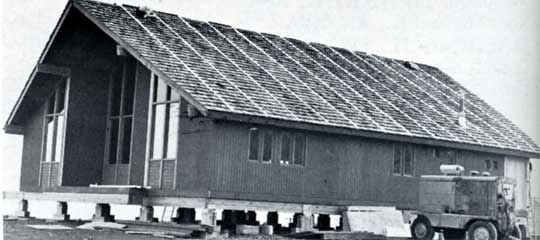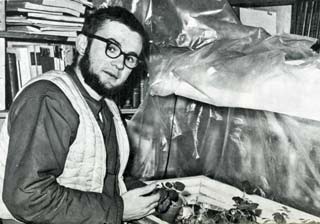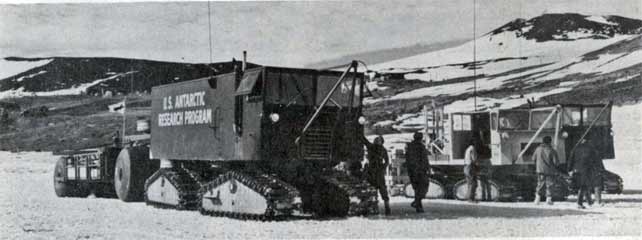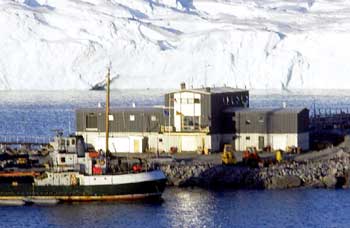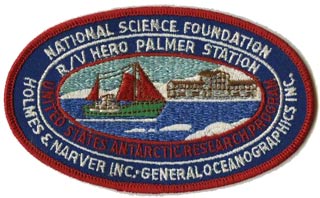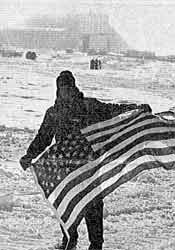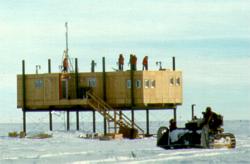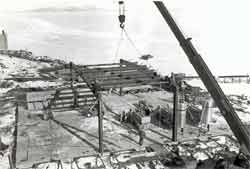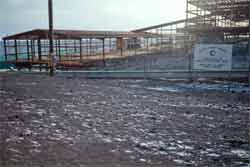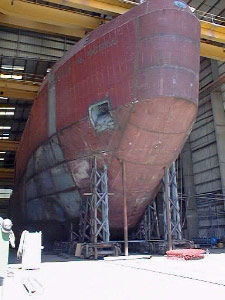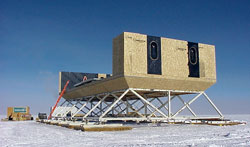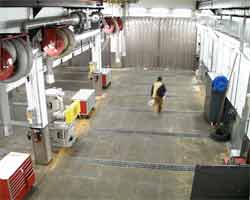The Chalet was the first building constructed by a civilian contractor, in 1969-1970, in one season except for some Navy earthwork in the previous season.. This distinctive prefabricated structure, the main NSF office facility in McMurdo, was the first major building project completed by a prime NSF support contractor, which at the time was Holmes and Narver, Inc. (H&N). More information, photos, and credits, including information on the Chalet this structure replaced...
My coverage of the 2007-2011 Antarctic support contract rebid and its award to the Lockheed Martin Corporation has been moved to a separate page. The Antarctic jobs information page is here. The historical background: Briefly...since the late 1970s, the contract rebid process has happened every 10 years until most recently...and the announced schedule of events (read on) has been pretty much the same each time...except that it must now be noted that the contract period which, er, was originally to start in 2010 and run for a maximum of 13 years rather than ten (!) Since the late 1960s the National Science Foundation (NSF) has increasingly relied on a prime private contractor to provide science support, operations and maintenance, logistics support and construction in the Antarctic. How'd we get where we are now (and where are we now, anyway)? Operation Deep Freeze, the beginning of America's current Antarctic research program, began in 1955-56 in preparation for the International Geophysical Year (IGY), and the support force at that time was the U. S. Navy. However, even then, it was recognized that private companies were better equipped to provide certain aspects of support. During the first summer at McMurdo, Chicago Bridge & Iron (CB&I) had welders on site working with the Seabees constructing two fuel storage tanks--a 250,000 gallon tank for aviation gasoline and a 100,000 gallon tank for diesel fuel. | |
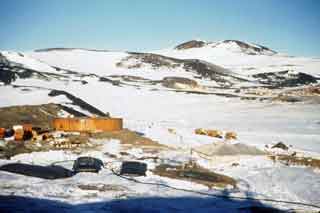 Here's a view of the avgas tank...the smaller diesel fuel tank was also constructed nearby, and CB&I would return the following season to construct another 250,000 gallon avgas tank near this one. This DF-I photo by Dave Grisez is from the USAP Photo Library (link to original). |
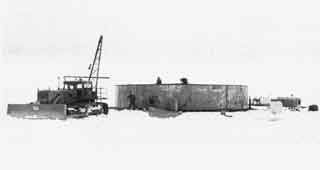 CB&I welders also worked assembling a 100,000 gallon avgas tank at Little America V near Kiel Field.The footings for this tank consisted of pallets placed side by side on the ice and tied together with 1-inch by 8-inch pieces of dunnage. No settlement of the tank was noticed during the first two weeks after completion.This U.S. Navy photo is from this Wikimedia Commons page. |
|
Speaking of Little America V...one of the DF-I winterovers was not exactly a contractor, but an experienced filmmaker working for Walt Disney--Lloyd Beebe (here is an August 2000 interview with Lloyd conducted by Brian Shoemaker for the Ohio State/American Polar Society oral history project). He produced a number of films for the Defense Department as well as for the Disney organization... including "The Seven Cities of Antarctica" which some of you may have seen (I have it on VHS but I can no longer find a public link). He was assisted by Elmo Jones, a Coast Guardsman who wintered at McMurdo but was also paid by the Disney organization. The American scientific participation in IGY projects worldwide--not just in Antarctica--was organized and coordinated by the United States National Committee for the International Geophysical Year (USNC-IGY), which had been created by and under the National Academy of Sciences in March 1953. After a decision was made to continue American research in Antarctica, while there was no disagreement that the Navy would continue to provide support, a fair amount of discussion was required to establish that the National Science Foundation would support the continuing scientific projects, and how that support would be managed. The final issue of the USNC-IGY monthly Antarctic Status Report dated December 1958 concluded with the paragraph "...this December Antarctic Status Report will be the last issued by the USNC-IGY. Future status reports will be issued by the National Science Foundation." [These reports and others are available here.] Meanwhile...the scientific program was temporarily labeled the "US Continuing Antarctic Research Program," as a 1959 Pole winterover once told me his baggage and cargo was labeled "CARP." The United States Antarctic Research Program (USARP) was not officially organized until March 1959, well after Pole had closed for the winter.
Perhaps the first significant specific laboratory support contract was awarded to Stanford University in 1960--a 5-year contract to operate the biolab in McMurdo, and that year the facility, later known as the Eklund Biological Center, was doubled in size. This contract was assumed by North Star Research and Development Institute of Minneapolis, MN, in October 1965. I'm not clear how the selection process went for these small early contracts. Meanwhile, the first exclusive NSF Antarctic research vessel, a converted cargo vessel known as the USNS Eltanin, was placed in service in June 1962...operated by the U. S. Navy. The next evolution in the business of Antarctic support contracting again involved the marine side...as plans for the permanent Palmer Station, to be constructed by the Navy's Seabees, were being finalized. In July 1966 a contract was awarded to Harvey F. Gamage, Shipbuilder, Inc., of South Bristol, Maine, for the construction of the 135-foot research vessel Hero. When the vessel and the permanent station were placed in service, Marine Acoustical Services (MAS) of Miami, Florida, had a 3 year contract to operate the ship as well as the biolab at Palmer Station (right, the Hero at Palmer Station, 1977 photo by Gary Cullen). Shortly after the contract award, MAS was purchased by TRACOR, which in the late 90's became part of BAE. At some unknown point in the early 1970s the contract was awarded to Hydrospace-Challenger Inc. (HCI), interestingly this corporation was owned by EG&G, which would later successfully participate in the Antarctic Support Associates joint venture. 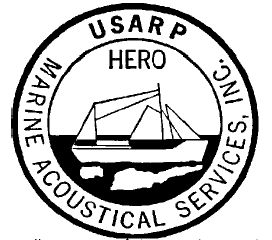 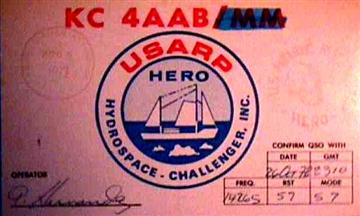 A cachet and a QSL card for the R/V Hero from the first years of that vessel's operation, featuring the names of the support contractors. In the late 1960s, both the Navy and NSF explored the possibility of increasing the role of private support contractors. In 1967, Rodney Gray of ITT was one of the consultants employed in this study--he would later serve as the project director for ITT's major USARP support contract in the 1980s. Meanwhile back on the other side of the continent, in 1968 Holmes & Narver (H&N) was awarded the science support contract for McMurdo, taking over in the 1968-69 summer season. The contractor support role was growing...as by this time the Field Party Processing Center--later renamed the Berg Field Center (BFC), was being fitted out. Another significant impetus toward reducing the extent of military support came in 1971--an executive order effective 1 July of that year shifted the Antarctic program responsibility and funding management from the Navy to NSF. This action was due in part to the close political scrutiny which was being placed on the defense budget at the time--when the war in Southeast Asia was a significant part of the defense budget. 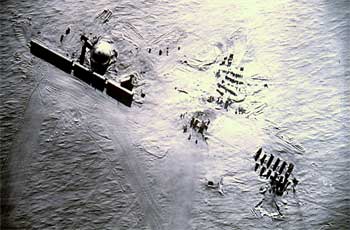
Another impetus for expanding the scope of the support contractor was the construction of the new domed South Pole Station (left, NOAA photo) (more project details). The Navy took this large project to the field in 1970-71 and did quite well with it, but they eventually had to deal with limited manpower and lack of specific trade expertise...due in no small part to the increasing demand for Seabee units in Southeast Asia. Accordingly, H&N furnished about 33 workers during the 1973-74 season-- they primarily dealt with some of the more specialized utility work. At the beginning of the following season (1974-75) the last Navy crew at Pole turned over the old IGY-era station to Dick Wolak, its first civilian manager, the H&N support team, and the construction crew that showed up to finish the domed station in time for its dedication in January 1975. Two H&N employees in particular worth mentioning are Robert Byrd Breyer, the grandson of Admiral Byrd. He was living in Anaheim and saw the ads for Pole construction workers...and the rest is, well you know. Robert spent lots of time in the utilidor insulating the water, sewer and glycol piping. And then there was Jerry Marty, who later came back to Pole as the NSF construction manager for the present elevated station.
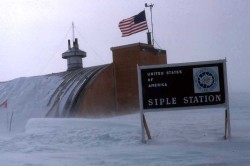
Meanwhile...the first in what has become a series of 10-year support contractor bidding cycles was underway, with much the same schedule that is being followed in the current process. The contract preliminary information and RFQ was issued in the 8th year of the decade...bidder site visits to the ice occurred during the 8-9 austral summer, final proposals were due in the middle of the 9th year, and contract award occurred later in that year. The new contractor started taking over during a transition period that encompassed the 9-0 austral summer, taking over completely on 1 April. In 1979 the precedent was set that continued for the next two contract cycles--NSF selected a new support contractor. In this case it was ITT Antarctic Services, Inc., (ITT/ANS), and thus the support offices moved from H&N's new building in Orange, CA to the headquarters of ITT Federal Electric Corporation (FEC, ITT's communications and support contracting division) in Paramus, NJ. ITT/ANS completed the hiring of winterovers for the 1980 season.
The next major construction effort was in McMurdo...ITT/ANS folks showed up in 1980-81, the first austral summer season of their new contract, to deal with completion of the new power plant as well as the 203-205 series of dorms. At right, steel erection for the power plant early in the 1980-81 season-- the plant was on line by the end of the summer (photo from Nick Majerus). The workforce was rather small by today's standards--in 1980-81 the entire ITT/ANS crew could fit into the Chalet for All Hands meetings. At the end of the decade ITT/ANS began the first phase of the replacement science facility, later to be dedicated the Crary Science and Engineering Center (above left, the structure of the first two pods as completed in February 1990, the last summer of the ITT/ANS contract). Construction work at the smaller stations during the 1980s was incremental rather than major--replacement power plant generator systems at Palmer and Pole...significant structural repairs to the Dome at Pole...new communications and computer systems at all stations (including an addition to the comms building at Pole. On the research vessel front, the NSF-owned R/V Hero was retired in 1984--replaced with the Polar Duke, a 212-foot leased ice-strengthened research vessel chartered from Rieber Shipping A/S of Norway. The vessel leasing arrangements evolved into direct USAP NSF contracts, although the support contractor continues to have a significant role in contract management and on-board science support operations.
ASA established a new office in the south suburbs of Denver, CO...while the old ITT/ANS/FEC offices in Paramus were emptied, closed up, and demolished. The 1990s was a period of accelerating turnover of McMurdo support activities from the Naval Support Force Antarctica (NSFA) to the civilian support contractor--this was completed in the 1997-98 season, when NSFA left the ice for the last time and was disbanded in 1998. On the research vessel front, NSF turned to Edison Chouest Offshore for its newer and larger next generation of research and support vessels. These were the Nathaniel B. Palmer, 308 feet, completed in 1992, and the smaller Lawrence M. Gould, 230 feet, completed in 1997. Both vessels were constructed at Edison Schouest's North American Shipyards in Larose, LA (a right, the Gould under construction in Larose in April 1997). The Polar Duke completed its last cruise to Palmer Station in May 1997. In the air, Navy helicopter support was replaced with a contract to Petroleum Helicopters, Inc., (PHI) beginning in the 1996-97 season...they started with one Bell 212 (the commercial equivalent to the Navy's UH-1N "Huey") and three smaller A-Star aircraft. These four helicopters were supported that year by 7 pilots and 5 mechanics. Meanwhile, McMurdo also saw a few significant efforts to subcontract the food and janitorial services beginning in the middle of the decade. 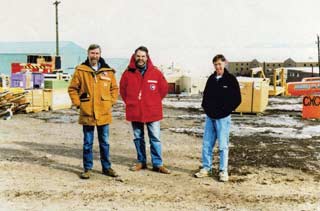 Here's an interesting aside, given that there have been many master plans for McMurdo between the early 1960s and, well, today. At left in a November 1996 McMurdo photo...3 men who played a significant part in program facilities construction and science support for many years. At left, Jim Chambers...project engineer for ASA, and earlier in the 1970's for Holmes & Narver. Center, Dave Bresnahan, an NSF representative for many years. And at right, Frank Brier, who was a H&N and NSF consultant in the 1970's--he later would direct the construction program for NSF, including the new elevated station at Pole. Oh, what is happening here? These 3 men are standing on a future McMurdo supply warehouse site. As of 2013 there is no warehouse there, even though these same 3 people stood on the same future warehouse site (in the same order in the photo) back in the late 70s. Photos courtesy of Dave Bresnahan. Here's an interesting aside, given that there have been many master plans for McMurdo between the early 1960s and, well, today. At left in a November 1996 McMurdo photo...3 men who played a significant part in program facilities construction and science support for many years. At left, Jim Chambers...project engineer for ASA, and earlier in the 1970's for Holmes & Narver. Center, Dave Bresnahan, an NSF representative for many years. And at right, Frank Brier, who was a H&N and NSF consultant in the 1970's--he later would direct the construction program for NSF, including the new elevated station at Pole. Oh, what is happening here? These 3 men are standing on a future McMurdo supply warehouse site. As of 2013 there is no warehouse there, even though these same 3 people stood on the same future warehouse site (in the same order in the photo) back in the late 70s. Photos courtesy of Dave Bresnahan.
But by this time the next new contract proposal was on the street...with a juicy new chunk of work--South Pole! There had been some consideration to awarding the SPSM construction contract separately, but in the end it was incorporated in the master support contract. The bidders came out...and when the dust settled, this press release came out of Raytheon's Vienna, VA headquarters on 29 October 1999. The news was spread on the ice through this 31 October 1999 Antarctic Sun article. But all was not said and done right away. ASA launched a protest, leaving ice folks pondering their fate for a bit longer. This was finally resolved (at least for all practical purposes) in late January (30 January 2000 Antarctic Sun article), and Raytheon Polar Services Company (RPSC) assumed full control, taking over the former ASA offices in Englewood, CO. As for the current contract period, things continue to go well. The science is getting bigger and bigger--witness the 10 meter telescope at Pole, new buildings at McM such as the Long Duration Ballooning (LDB) buildings, the Science Support Center (SSC) and the Joint Satellite Operations Center (JSOC), and increasing activity by those two large research vessels. Some months before the official dedication of the new South Pole Station, speculation started to emerge about the next contract rebid. Of course, based on history (such as what you've seen on this page) it was not unexpected. The rumors started to fly in 2007, and the prospective bidders started to position and posture. Finally, early in 2008 some official news started to come out.... My coverage of the 2008-2012 activities involving the bidding and award of the current USAP support contract...and some subsequent events...are on this page. Okay...sorry, I'm an old Polie construction guy, and not a bean counter or contract administrator. So what you get from me is the historical take on this interesting ongoing event, rather than number crunching secrets and inside info. That certainly isn't the only viewpoint...if you're looking for another one I would highly recommend that of fellow Polie (2004) winterover and friend, the late Nick Johnson, who had a unique take on the 2000 contract changeover at http://bigdeadplace.org/the-contract-changeover-1999-00/index.html...not available now, perhaps that may yet change someday. | |
